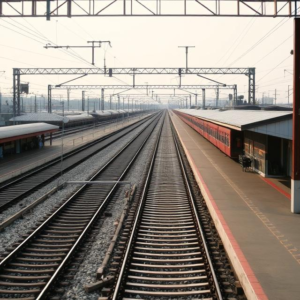Railway infrastructure and development in India refer to the physical structures and improvements made to the railway system to make it more efficient, modern, and safe. India has one of the largest rail networks in the world, and its infrastructure is constantly being worked on and improved to meet the growing demand for transportation.

Here’s an easy breakdown of railway infrastructure and development in India:
1. Railway Tracks (Rail Network)
- What It Is: The railway tracks are the foundation of the entire rail system. They are the paths on which trains travel.
- Development: India has over 67,000 km of railway tracks, making it one of the largest rail networks globally. The government is working to expand this network, adding more tracks to underserved regions, and converting older tracks into broad gauge (wider tracks that allow faster trains).
- Upgrade: New tracks are being laid in areas that need better connectivity, and old tracks are being replaced with better materials to reduce accidents.
2. Stations (Railway Stations)
- What It Is: Railway stations are the places where passengers board and alight trains. They have platforms, waiting areas, ticket counters, etc.
- Development: Many railway stations are being modernized and renovated to make them more passenger-friendly. For example, some stations now have air-conditioning, better waiting areas, and digital ticketing systems. Major stations are being upgraded to handle more passengers with modern amenities like Wi-Fi, escalators, etc.
- Future Plan: The government plans to redevelop around 1,000 railway stations under the Station Redevelopment Program to improve facilities and make them more comfortable.
3. Electrification
- What It Is: Electrification means converting diesel engines to electric ones by providing electricity through overhead wires or through third rails.
- Development: India is working towards 100% electrification of its railway network, which will reduce the reliance on diesel and help make the trains more eco-friendly. Electrification also improves the speed and efficiency of trains.
4. Modernization of Trains
- What It Is: This involves upgrading old trains and introducing new, more advanced trains.
- Development: New trains like the Vande Bharat Express and Tejas Express are introduced to give passengers a better experience with features like Wi-Fi, comfortable seating, automatic doors, and modern amenities. These trains are faster and safer.
- Future Plan: The goal is to introduce more high-speed trains, which can travel at speeds of up to 160 km/h or more.
5. Signaling Systems
- What It Is: Signaling systems are used to control train movements, ensuring trains run on time and avoid accidents.
- Development: India is upgrading its old signaling systems to modern digital signaling systems, which are more accurate and efficient. This will help avoid train delays, improve safety, and increase the number of trains that can run on the same tracks.
6. Safety Improvements
- What It Is: Safety measures are essential to prevent accidents and ensure passengers’ security.
- Development: India has introduced many safety features like Automatic Train Protection (ATP), train collision avoidance systems, and better track maintenance. There are also improvements in platform fencing, CCTV surveillance, and fire safety.
- Future Plan: Safety is a top priority, and continuous efforts are being made to introduce more modern systems, like smart coaches and drone inspections, to reduce accidents.
7. Dedicated Freight Corridors
- What It Is: These are special railway corridors built just for transporting goods (freight) to increase efficiency.
- Development: India is building two major Dedicated Freight Corridors (DFC): one from Delhi to Mumbai and another from Kolkata to Mumbai. These will help transport goods faster, reduce congestion on passenger tracks, and improve overall logistics.
8. High-Speed Rail
- What It Is: High-speed trains travel at speeds over 200 km/h.
- Development: India is working on building high-speed rail corridors (like the Mumbai-Ahmedabad Bullet Train Project) that will connect major cities at much faster speeds. This is a big step toward modernizing the rail system and providing better travel options.
9. Public-Private Partnerships (PPP)
- What It Is: The government is collaborating with private companies to fund and develop various railway projects.
- Development: Several private companies are now allowed to run trains and build infrastructure, which helps bring in modern technology, investment, and better management. This partnership helps speed up the development of the railway system.
10. Green Initiatives
- What It Is: The government is focusing on making railways more eco-friendly and sustainable.
- Development: Solar panels are being installed on trains and stations, and efforts are being made to make the railways carbon-neutral. The goal is to reduce the environmental impact of the railway system.
Summary
In simple terms, India is continuously working on improving and expanding its railway system to meet the needs of growing population and economy. There are efforts to improve tracks, stations, safety, and technology, while also focusing on sustainability. The focus is on faster, safer, and more comfortable travel, while also ensuring that goods are transported efficiently.
Keywords: Indian Railway, Railway











